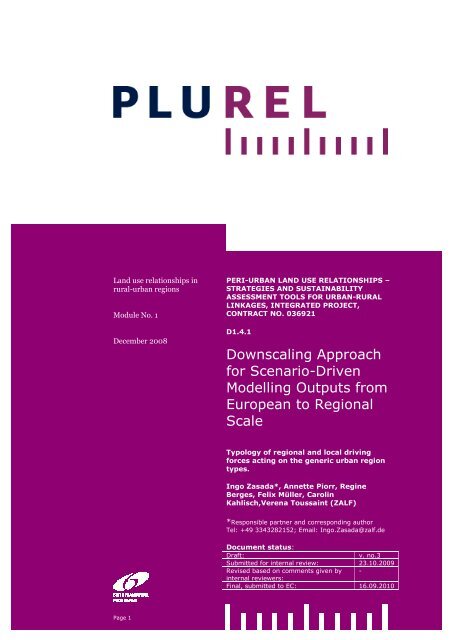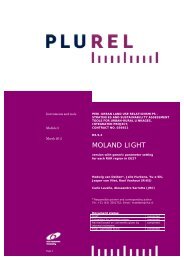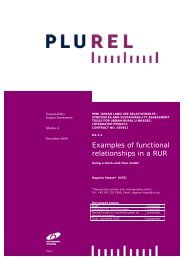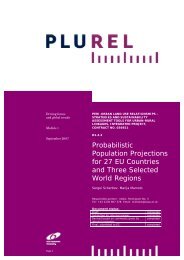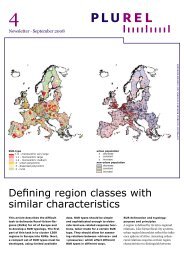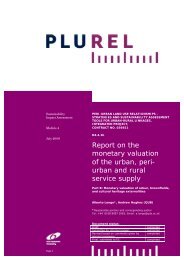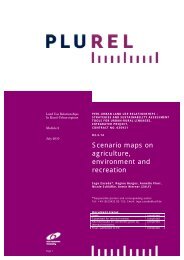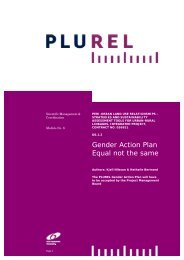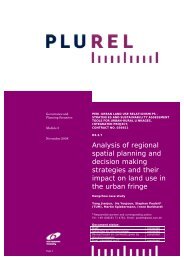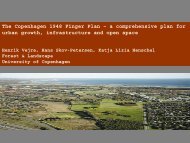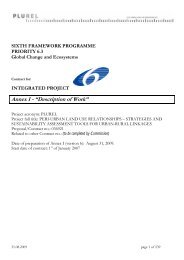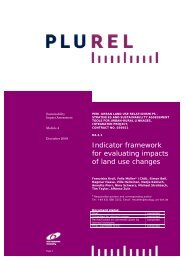Downscaling approach - Plurel
Downscaling approach - Plurel
Downscaling approach - Plurel
Create successful ePaper yourself
Turn your PDF publications into a flip-book with our unique Google optimized e-Paper software.
Land use relationships in<br />
rural-urban regions<br />
Module No. 1<br />
December 2008<br />
PERI-URBAN LAND USE RELATIONSHIPS –<br />
STRATEGIES AND SUSTAINABILITY<br />
ASSESSMENT TOOLS FOR URBAN-RURAL<br />
LINKAGES, INTEGRATED PROJECT,<br />
CONTRACT NO. 036921<br />
D1.4.1<br />
<strong>Downscaling</strong> Approach<br />
for Scenario-Driven<br />
Modelling Outputs from<br />
European to Regional<br />
Scale<br />
Typology of regional and local driving<br />
forces acting on the generic urban region<br />
types.<br />
Ingo Zasada*, Annette Piorr, Regine<br />
Berges, Felix Müller, Carolin<br />
Kahlisch,Verena Toussaint (ZALF)<br />
*Responsible partner and corresponding author<br />
Tel: +49 3343282152; Email: Ingo.Zasada@zalf.de<br />
Document status:<br />
Draft:<br />
v. no.3<br />
Submitted for internal review: 23.10.2009<br />
Revised based on comments given by -<br />
internal reviewers:<br />
Final, submitted to EC: 16.09.2010<br />
Page 1 • PLUREL Deliverable Report 1.4.1 • October 2009<br />
Page 1
Contents<br />
Contents ..................................................................................................... 2<br />
1 Abstract ................................................................................................... 3<br />
2 Introduction ............................................................................................ 6<br />
3 Impacts of Regional Determinant Framework on Urbanisation ............ 11<br />
4 Scenario-related Determinant-weighting ............................................... 16<br />
References .................................................................................................. 18<br />
Annex ......................................................................................................... 20<br />
Page 2 • PLUREL Deliverable Report 1.4.1 • October 2009
1 Abstract<br />
This report aims at delivering a concept of regional adaptation of scenario<br />
storylines and modelling data derived from scenario modelling at national scale<br />
to a higher disaggregated scale. This <strong>approach</strong> has been developed as an<br />
integrative element for the scenario-modelling cascade of the PLUREL project.<br />
The research task dealt with in this report provides an interface between Module<br />
1 and Module 2.<br />
Starting point for the establishment of the algorithm is the scenario-output<br />
modelling at national level, predicting urban land-use change as a result of a<br />
changing demographic and economic framework on NUTS 0 level. A procedure<br />
for the further disaggregating to regional level (NUTS 2) based on storylines (M1,<br />
see Carter, 2007) and parameterized projections (IIASA, NEMESIS models) of<br />
future European development scenarios has been developed.<br />
The method includes expert estimations on the influence of six different regional<br />
characteristics (accessibility, innovation, environmental quality, natural and<br />
technological hazard, and the regulatory regime) on urban land use change in the<br />
four PLUREL scenarios. The results are aggregated to an index providing a value<br />
for each NUTS2 region. Hence the framework delivers a generic <strong>approach</strong> for<br />
downscaling scenario specific outputs to NUTS 2-level.<br />
The report describes the generic downscaling <strong>approach</strong> and its outcomes in the<br />
following elements:<br />
- the varying influence of regional determinants on urbanisation process<br />
- the scenario-related differences of those determinants.<br />
The results show that the six determinants, according to literature, act either as<br />
incentives or as constraints to urban growth. Moreover their aggregated influence<br />
differs between the four scenarios. Thus different index values for the strength of<br />
urban growth or shrinkage could be allocated to the NUTS2 regions in Europe.<br />
Page 3 • PLUREL Deliverable Report 1.4.1 • October 2009
Popular science description<br />
Apart from the normally used factors (drivers) of urbanisation for future regional<br />
projections – namely Population and GDP, the focus of the alternative <strong>approach</strong><br />
presented here is on more general, static characteristics of regions which<br />
influence urbanisation. They can be divided into incentives and constraints to<br />
urban growth. On the one hand there are the accessibility of regions, their<br />
innovation capacity and the quality of the environment. These three act as<br />
promoters of urban growth, as they raise the attractiveness of regions for people.<br />
On the other hand the thread of natural or technological hazards, such as land<br />
slides or plane crashes, as well as the strength of the regulatory regime curbs<br />
urban growth. Building houses in these regions is more risky or even forbidden<br />
and therefore constrained.<br />
But how strong is their influence in the four different PLUREL scenarios For<br />
example in the Water World scenario, where natural disasters are supposed to<br />
increase, the natural hazard potential will probably have a stronger impact on<br />
urban growth. Therefore experts were asked to weigh the determinants for each<br />
scenario according to their influence. The, to an index aggregated, results show a<br />
divers picture for the NUTS2 regions in Europe. They show increased urban<br />
growth for all scenarios except from the Water World scenario. Here the<br />
constraints to urban growth have a stronger influence than the incentives.<br />
Page 4 • PLUREL Deliverable Report 1.4.1 • October 2009
Classification of results/outputs:<br />
Spatial scale for results:<br />
Regional, national, European<br />
NUTS 2<br />
DPSIR framework:<br />
Driver, Pressure, State, Impact,<br />
Response<br />
Driver -Pressure - State<br />
Land use issues covered:<br />
Housing, Traffic, Agriculture, Natural<br />
area, Water, Tourism/recreation<br />
Urban land use<br />
Scenario sensitivity:<br />
Are the products/outputs sensitive to<br />
Module 1 scenarios<br />
Yes (the regionalisation index)<br />
Output indicators:<br />
Socio-economic & environmental external<br />
constraints; Land Use structure; RUR<br />
Metabolism; ECO-system integrity;<br />
Ecosystem Services; Socio-economic<br />
assessment Criteria; Decisions<br />
Knowledge type:<br />
Narrative storylines; Response functions;<br />
GIS-based maps; Tables or charts;<br />
Handbooks<br />
Regionalisation Index<br />
Tables, Spidergrams, Maps<br />
How many fact sheets will be derived<br />
from this deliverable:<br />
none<br />
Page 5 • PLUREL Deliverable Report 1.4.1 • October 2009
2 Introduction<br />
In the framework of impact assessment and political decision-making support,<br />
scenarios represent tools to develop assumptions on future sets of conditions<br />
including society, economy, technology or climate. Rather than forecasting future<br />
developments, recent European-wide scenario development processes, such as<br />
IPCC Special Report on Emission Scenarios, PRELUDE or PLUREL (EEA 2007;<br />
Nakicenovic et al. 2000; Ravetz 2008; Reginster and Rounsevell 2006) refer to<br />
possible futures, which explore certain development trajectories. Those scenario<br />
<strong>approach</strong>es make use of narrative storylines and qualitative descriptions of socioeconomic,<br />
technologic and climatic driving forces under the particular regard of<br />
urbanisation processes. Qualitative storylines allow a heuristic <strong>approach</strong> with<br />
uncertainties, providing scenario requirements, such as plausibility and<br />
consistency as well as a high degree of understanding by experts and<br />
policymakers (EEA 2007). Piorr (2008) assessed both drivers and scenarios in<br />
the context of land use change. She outlined the main factors leading to land use<br />
changes, and changes in ecosystem services and functions and highlighted the<br />
need to develop downscaling procedures for scenarios in order for them to be<br />
applied at different scales.<br />
In the case of the scenario development of PLUREL, four future scenarios along<br />
the two dimensions environmental-economical and regional-global orientation<br />
are distinguished (Ravetz 2008). Qualitative assumptions on the socio-economic<br />
and technological development as well as to the degree of Land Use Change<br />
(LUC), energy use and urbanisation are outlined within the scenario storylines<br />
(Ravetz 2008).<br />
Land-use development, especially in the context of urbanisation is first of all<br />
related to socio-economic drivers. But nevertheless the European Environmental<br />
Agency concluded that these are interacting with localised environmental and<br />
spatial constraints. Among regional socio-economic aspects the authors<br />
emphasise the importance of transportation and land use planning (EEA 2006).<br />
Additionally factors, such as innovation, environmental quality as well as natural<br />
and technological vulnerability are of importance to regional occurrence of land<br />
use change.<br />
This report outlines a conceptual understanding of how both components of<br />
regional specification are integrated into the scenario-modelling cascade of the<br />
PLUREL project. Starting point for the establishment of the algorithm is the<br />
scenario-output modelling at national level, predicting regional urban land-use<br />
change as a result of a changing demographic and economic framework on NUTS<br />
0 level. A procedure for the further disaggregation to regional level (NUTS 2)<br />
based on storylines (M1, see Carter, 2007) and parameterized projections (IIASA,<br />
NEMESIS) of future European development scenarios has been developed. Hence<br />
the framework delivers a generic <strong>approach</strong> for downscaling scenario specific<br />
outputs to NUTS 2-level.<br />
Page 6 • PLUREL Deliverable Report 1.4.1 • October 2009
In general two different <strong>approach</strong>es are followed:<br />
- the general (varying) influence of regional determinants on urbanisation<br />
process<br />
- the scenario-related differences of those determinants.<br />
For the demographic and economic drivers modelling results were delivered at<br />
NUTS 0-level, simulated in the NEMISES model. Land use changes are<br />
transferred into the spatially explicit RUG land use model, through a Cellular-<br />
Automata-Model driven by spatial allocation rules for small-scale land-use<br />
distribution. The whole modelling cascade is outlined in Figure 3.<br />
For the regional determinants, related to planning and governance regimes,<br />
innovation and accessibility, hazard potential and environmental quality, the<br />
downscaling takes places via Regional Clustering as regionalisation step. Doing<br />
so, the modelling of a regionally comprehensive European scenario framework<br />
includes creating a multitude of regionally specific scenarios. Instead by<br />
compiling of regional impact clusters it is focused on regionally relevant aspects<br />
of future scenarios.<br />
Figure 3: Cascade scheme of scenario output modelling integrating <strong>Downscaling</strong> Model based on Regional<br />
Determinants<br />
Scenario Storylines<br />
A1, A2, B1, B2<br />
SCENARIO Modelling<br />
Qualitative assumptions<br />
Socio-ecomomic variables<br />
Econometric model NEMISIS<br />
(Urban) Land-use change on NUTS0 level (member state)<br />
REGIONALISATION Modelling<br />
Scenario sensitivity<br />
Urbanisation incentive (pull-factor)<br />
Urbanisation constraint (push-factor)<br />
Innovation<br />
Regional<br />
Accessibility<br />
Environment<br />
Quality<br />
Technolog.<br />
Hazard<br />
Natural<br />
Hazard<br />
Planning &<br />
Governance<br />
Participatory expert estimation<br />
Aggregated land-use relevance of Regional Determinants<br />
Regional Scenario Sensitivity Index on NUTS2 level (region)<br />
Page 7 • PLUREL Deliverable Report 1.4.1 • October 2009
2.1 Objectives of WP1.4<br />
WP1.4 aims at downscaling the impacts of the driving-force scenarios from the<br />
EU to the regional or even case study level. This is accomplished by the RUG<br />
model, which makes use of GDP, Population values and Land use outputs from<br />
NEMESIS. Moreover an alternative <strong>approach</strong> is developed; relying on different<br />
typologies apart from the NEMESIS outputs (DOW 2009). This <strong>approach</strong> is the<br />
topic of the report at hand.<br />
Integration within the PLUREL work flow<br />
The two above named elements of this report can be applied separately or<br />
together in order to specify response functions, developed in WP2.3 in a regional<br />
context and related to the scenarios of M1. In this sense, D1.4.1 delivers a part of<br />
the tool-box for downscaling. The RUG model (D1.4.2) is an additional part of<br />
this toolbox. Vice versa, deliverable D2.3.1 (preliminary version= Milestone<br />
report M2.3.6) takes up this interface between M1 and M2 from the Module 2<br />
point of view.<br />
By implementing a participatory <strong>approach</strong>, integrating different kinds and levels<br />
of knowledge and experience (based on literature, experts, stakeholders and<br />
practitioners), the added value for the research is gained. The knowledge base has<br />
been broadened and as well the <strong>approach</strong> as the weighting procedures and results<br />
have undergone a valuation procedure.<br />
Integration within the PLUREL products<br />
Product chains<br />
This deliverable is related to one product chain. Product chains have been defined<br />
in order to structure physical project outputs towards the final user interface of<br />
PLUREL, the former SIAT-RUR – now iIAT. They specify what kind of output is<br />
expected to be delivered. Deliverable D1.4.1 presents the textual description<br />
related to the two products listed in table 1.<br />
Table 1: D1.4.1 within the PLUREL product chain III<br />
Chain no. Product Sub products Kind<br />
sensitive to<br />
M1 Scenarios Modules Main partners<br />
III<br />
Thematic<br />
clusters in<br />
Europe<br />
Thematic clusters (NUTSX), based<br />
on: Innovation trends; Accessibility;<br />
Hazard risks; Planning and<br />
Regulatory regime<br />
maps,<br />
graphs<br />
yes<br />
WP 1.4,<br />
WP2.2,<br />
WP2.3 ZALF, SYKE<br />
Knowledge chains<br />
This deliverable has a highly integrative position within the PLUREL project, as it<br />
contributes to two knowledge chains. The scenario chain 1 brings the<br />
global scenarios into a regional storyline context. The downscaling of<br />
data chain presents the operational procedure of bringing the<br />
modelling outputs from M1 from the national scale to a regional scale,<br />
taking into account regional differentiation factors and transferring<br />
them into a spatially explicit context.<br />
Page 8 • PLUREL Deliverable Report 1.4.1 • October 2009
Figure 1 shows the position of D1.4.1 in the scenario chain 1, and Figure 2<br />
respectively for the downscaling of data chain.<br />
scenario chain 1<br />
M1 scenario storylines (UMan et al.)<br />
regionalisation of storylines (ZALF)<br />
thematical specification (e.g. transport system) (UMan)<br />
application to response functions (SYKE)<br />
Figure 1: D1.4.1 within the scenario knowledge chain 1<br />
downscaling of data - chain draft, Oct 2008<br />
scenario output regionalisation explicit mapping LUC impact operability at different scales<br />
module M1 M1 M1, M2 M2 M2, M3, M4<br />
examples WP2.3<br />
in charge UEDIN/ ERASME ZALF UEDIN/ ARCS/ SYKE all M2 UFZ/ZALF<br />
stakeholders<br />
scale NUTS1-NUTS3 GRID NUTSX Leipzig case<br />
clusters<br />
hotspots<br />
spatial data CLC map regional new sensitivity<br />
sensitivity scenario related analysis<br />
clusters CLC map Leipzig case<br />
admin.data NEMESIS new Spatial LU Classification SIAT<br />
modelling output data distribution shares Allocation Response and function in depth<br />
distribution CLC classes CLC classes Rules Functions groundwater recharge paper, book<br />
M1<br />
paper submitted<br />
Figure 2: D1.4.1 within the knowledge chain “downscaling of data”<br />
Dissemination activities<br />
The results of this research have been disseminated as follows<br />
Piorr, A. 2008. Changes in urban and peri-urban land use: <strong>approach</strong>es and<br />
problems of assessing drivers and scenarios. In: Ecosystem Services and Drivers<br />
of Biodiversity Change. Report of the RUBICODE electronic conference, April<br />
2008, 47-48.<br />
http://forums.ceh.ac.uk:8080/~rubicode/upload/Rubicode_report.pdf<br />
Berges, R, Zasada, I, Piorr, A., 2009. Regionalization of land use change scenarios<br />
based on expert knowledge. Ecology and Society. Submitted in January 2009<br />
Ingo Zasada, I, Berges, R, Piorr, A, 2009. A Generic <strong>Downscaling</strong> Approach for<br />
Scenario Driven Modelling Outputs from European to Regional Scale. Integrated<br />
Assessment of agriculture and Sustainable Development, AgSAP Conference<br />
2009, Netherlands. Poster accepted<br />
2.2 Objectives of the deliverable<br />
The objectives of the deliverable are, as stated in the DOWs description of WP 1.4,<br />
to show an alternative concept for the regionalisation of the scenarios and land<br />
use models. It is one tool in the downscaling toolbox created by WP 1.4 and can<br />
be applied separately or in combination with the RUG model. Products of D 1.4.1<br />
Page 9 • PLUREL Deliverable Report 1.4.1 • October 2009
are tables for the six different regional determinants and the indices created with<br />
the help of expert estimations on the scenarios. The weighing factors can be<br />
visualised in spidergrams. Based on the index values pan-European maps are<br />
created.<br />
2.3 Structure of the deliverable<br />
The report is structured according to the two elements of the described<br />
downscaling <strong>approach</strong>. Chapter 3 describes the six different regional<br />
determinants and their behaviour as incentives or constraints to urban growth.<br />
Chapter 4 shows the expert evaluation method of the determinants in the four<br />
PLUREL scenarios and its results.<br />
Page 10 • PLUREL Deliverable Report 1.4.1 • October 2009
3 Impacts of Regional Determinant<br />
Framework on Urbanisation<br />
The economic and demographic driven scenario modelling in Module 1 generates<br />
land-use changes at NUTS0. Except socio-economic key factors the entire<br />
European Union is more or less regarded as a uniform entity. According to the<br />
work plan and the models capabilities, regional spatial and structural differences<br />
are not taken into account.<br />
In Module 2, responses for different land-use functions at NUTSX level (scale<br />
between NUTS2 and NUTS3) are expected to be calculated for the different<br />
scenarios. In order to achieve a regional differentiation, a generic <strong>approach</strong> has<br />
been applied. Based on a literature survey, beyond demography and economic<br />
development, the most important determinants for land use changes resulting<br />
from urbanisation processes have been identified: planning and governance,<br />
innovation and transportation, hazard potential and environmental quality. As<br />
important regionalising determinants they are used to define spatially explicit<br />
Regional Clusters. These can be either continuous macro-regions (e.g. Alpine<br />
region, Eastern Europe) or hot-spot-regions occasionally quite small-scale<br />
structured (e.g. capital or island regions). These characteristics can enhance or<br />
restrict the extent of land-use change. In the following the six determinants and<br />
their impact on land-use change are briefly presented.<br />
3.1 Planning and Governance<br />
The European Union is characterised by varying, historically developed governing<br />
and planning systems. They represent an aspect, which macro-regionally shapes<br />
European-wide outputs of development scenarios.<br />
Government and planning structures in Europe can be distinguished regarding<br />
sizes of administrative entities, competencies of horizontal administrations<br />
(municipalities, counties, regions, and national states), general extent of<br />
governing intervention of formal and semi-formal structures (governance).<br />
Regarding the planning regimes cornerstones of the classification are the vertical<br />
governing <strong>approach</strong> (bottom-up vs. top-down), the extent of state intervention<br />
(restrictive vs. ‘laissez fair’) as well as the degree of communication and cooperation<br />
in planning (Lalenis and Tosics 2008; Dasí 2006). The planning and<br />
policy framework determines the urban development pattern. Although hardly<br />
quantified in extent of impact on land-use change the role of planning and<br />
governance is non-negligible, due to different pattern of legal, constitutional and<br />
administrative framework planning and governance systems have an impact on<br />
Land Use Change itself. Weak planning facilitates unwanted growth of lowdensity<br />
urban sprawl (EEA 2006), whereas restrictive <strong>approach</strong>es are much more<br />
capable to manage growth or encourage less land consuming dense urban<br />
development.<br />
Lalenis and Tosics (2008) provide a typology for the regulatory framework<br />
pattern throughout Europe combining the spatial planning style with the level of<br />
state intervention (Cf. Figure 4). In general the traditional five planning system<br />
Page 11 • PLUREL Deliverable Report 1.4.1 • October 2009
types British, Napoleonic, Germanic, Scandinavian as well as East European can<br />
be distinguished. Within national states the system is more or less homogenous.<br />
Differences occur only in countries with autonomous and federal regions<br />
structure like the UK and Germany. Dealing with future scenarios it needs to be<br />
kept in mind that through the European harmonisation process and the general<br />
increase of competencies of the supra-national body of the EU will lead also to a<br />
harmonisation of national governing and planning regime. Differences between<br />
the types are increasingly blurred.<br />
3.2 Regional hazard potential and vulnerability<br />
Cities and regions are exposed to natural and technological hazards<br />
corresponding to their geographical and topographical location, either on daily<br />
basis or as single disasters (Pelling 2003). They emerge either as direct impacts,<br />
like mainly human casualties, and the destruction of physical structures of<br />
settlement and infrastructure or as systemic impacts on economic and income<br />
losses (Pelling 2003). The Inter-Agency Secretariat of the International Strategy<br />
for Disaster Reduction - UN/ISDR (2004) distinguishes natural hydrometeorological<br />
and geological hazards from technological hazards as result of<br />
major accidents associated with industrialization and technological innovation.<br />
Natural hazards, like floods, droughts, wildlife fires, volcanic or biological<br />
hazards result in the region’s bio-physical framework, like in coastal and riverine,<br />
mountainous or low-precipitation regions. Technological hazards, such as plane<br />
crashes, chemical leakages or even nuclear meltdowns are related to the<br />
adjacency to urban agglomerations.<br />
Both kinds of hazards are interrelated with urbanisation resulting in a vicious<br />
circle as stated by Pelling (2003). On the one hand urban areas are in many cases<br />
located within natural hazard zones and prospectively impacts of climate change<br />
will in particular affect those hotspot areas (IPCC 2000). On the other hand the<br />
further urbanisation process featured by a concentration of people and assets<br />
increases the regional vulnerability to disasters (Quarantelli 2003).<br />
Anthropogenic alterations and LUCs exacerbate the impacts of natural disasters<br />
(Abramovitz 2001).<br />
Vulnerability represents the exposure and inability to respond to hazards. In<br />
urban areas vulnerability is defined as physical and social vulnerability, focusing<br />
on the built structures and on society and economy. In contrast, the capability to<br />
respond to hazards defines the degree of resilience (Pelling 2003). The ESPON<br />
project 1.3.1 (Schmidt-Thomé 2006) analysed the European pattern of natural<br />
and technological hazard potential (Cf. Figures 5 and 6).<br />
3.3 Innovative capacity<br />
Urban development is strongly depended on regional economic performance as a<br />
measure of competitiveness, comparative advantage and the degree of regional<br />
specialisation. Within a knowledge-based society regional competitiveness is<br />
among others based on innovative capacity (Acs 2002), or in other terms the<br />
innovation system (Cooke 2001). Regions differ both in performance as<br />
contributor as well as in their behaviour as applier of innovation. The European<br />
Innovation Scoreboard summarizes five indicators of innovation dimensions to<br />
an aggregated index of regional innovation performance, which assesses 203<br />
Page 12 • PLUREL Deliverable Report 1.4.1 • October 2009
European regions in a range between 0,90 and 0,01 (MERIT and JRC 2006).<br />
Regions can be classified into different groups using hierarchical clustering.<br />
Significant national and regional differences can be observed (Cf. Figure 7).<br />
3.4 Accessibility<br />
The role of accessibility, transportations costs and land use is already described<br />
by classical models of Von Thünen (1826) or Alonso (1964). The New Economic<br />
Geography (Krugman 1991) reinforces the importance of the region and centrality<br />
by emphasising the importance of agglomeration effects, the concentration of<br />
economic activity in certain central regions. Centrality is defined by the<br />
integration of a region into the European and global transportation network,<br />
consisting of air connection, motorway and rail network and harbour nodes,<br />
resulting in hierarchically differentiated space. European regions, which are well<br />
connected by transportation infrastructure, possess those gateway functions<br />
(Anderson and Anderson 2000) as basis of economic performance and<br />
contributing to urban growth, such as the regions of the Blue Banana or<br />
European capital regions. The ESPON project 1.2.1 (Mathis et al. 2004) assessed<br />
the European transportation network and evaluated the regional accessibility (Cf.<br />
Figure 8).<br />
On the regional level transportation has effects on certain region types according<br />
to characteristics of modes of transportation. The role of the use of the car is<br />
manifold studied (Newman and Kenworthy 1989). High car ownership, weak<br />
regional public transportation system, modal split with dominance of individual<br />
traffic are considered as main drivers of urban development beyond the former<br />
urban boundaries and a low-density, dispersed urban fabric.<br />
3.5 Environmental Quality<br />
Urban areas as location for housing, working, leisure and tourism are<br />
increasingly depended on the quality of the living environment. Environmentally<br />
healthy and attractive regions are increasingly subject to immigration.<br />
Environmental quality on regional scale is defined by bio-physical conditions,<br />
such as the proximity to natural amenities, like mountains and water<br />
(Marcouiller et al. 2002; Wu 2002), but also by the degree of anthropogenic<br />
influence on the region. Soil, water, air and biodiversity are key issues of<br />
environmental quality which are affected, in most cases, in a negative way.<br />
Whereas topographic features are measured and indexed, the anthropogenic<br />
impact is substitutionally represented by the degree of naturalness, measured by<br />
ESPON (2006), taking into account share of natural and artificial surface as well<br />
as the intensity of agricultural land use (Cf. Figure 9).<br />
Land use changes due to urbanisation processes are often connected to<br />
environmental impacts related to changed intensities in the use by agriculture,<br />
tourism, transport, and energy. Soil, water, air and biodiversity are the key issues<br />
of environmental quality which are affected, in most cases in a negative way.<br />
Depending on the intensity of changes, but also on land use tradition, or<br />
characteristics in certain areas (e.g. mining) European regions can be classified<br />
according to the status of the environmental quality.<br />
Furthermore “hotspots” can be identified in regions with specific environmental<br />
problems that characteristically develop due to locational source related<br />
Page 13 • PLUREL Deliverable Report 1.4.1 • October 2009
emissions (e.g. air pollution). Areas with a high density of industries and<br />
transportation networks certainly belong to this hotspot regions. On the other<br />
hand also regions with specific desired environmental potentials (e.g. Natura<br />
2000 areas) are to be designated in regional clusters.<br />
3.6 Summary<br />
The translation of future scenarios into regional land use results on NUTS 2 level<br />
relies upon a systematic assessment and categorisation of regional specificities:<br />
Regions characterised by specific determinants differ regarding their “sensitivity”<br />
towards European economic and demographic change regarding their land use<br />
development. In DPSIR terms: Their driver-pressure relations show a high<br />
degree of variety to the effect of regional push and pull factors:<br />
- Regions in countries with a highly restrictive planning system will display<br />
less sprawl intensities as a consequence of growth (or other kinds of socioeconomic<br />
change like shrinking of household sizes) than regions with a<br />
laissez faire planning regime. Both formal (government) and informal<br />
(governance) aspects play into this relationship.<br />
- Bio-physical conditions determine the environmental quality (slopes,<br />
mountains, water area, natural area) inhibit settlement growth. These<br />
conditions can change over time due to climate change.<br />
- Vulnerability to natural and technological hazards such as flooding<br />
landslide risk, water shortages as well as human caused accidents<br />
represent an other pull factor, decreasing regional probability for urban<br />
development.<br />
- The availability of certain technologies like transport technology affects<br />
the patterns and intensity of urban sprawl/growth, for example by<br />
expanding commuting areas.<br />
In the M1 modelling procedure, narrative storylines form the starting point for<br />
scenario development. Demographic and economic indicators are calculated<br />
according to the scenario storylines and fed into the NEMESIS land use change<br />
model, which projects the relative change of urbanised area for each NUTS 2<br />
region. The result however, does not take into account the heterogeneous<br />
structures of the European territory. In order to qualify and specify the results,<br />
but also to lay the basis for following steps of disaggregation, a rule set is needed.<br />
Page 14 • PLUREL Deliverable Report 1.4.1 • October 2009
CONSTRAINTS<br />
INCENTIVES<br />
Figure 4: Regulatory Regime at NUTS2<br />
Figure 7: Innovation Capacity at NUTS2<br />
Figure 5: Natural Hazard Potential at NUTS2<br />
Figure 8: Accessibility at NUTS2<br />
Figure 6: Technolog. Hazard Potential at NUTS2<br />
Figure 9: Environmental Quality at NUTS2<br />
Page 15 • PLUREL Deliverable Report 1.4.1 • October 2009
4 Scenario-related Determinantweighting<br />
4.1 Principle<br />
It is intended to regionalise the scenarios by integrating further qualitative factors<br />
including their scenario sensitivity based on expert knowledge. Thereby<br />
specification of the scenarios at hand takes place, leading to changed model<br />
results as we state that the regional framework, not yet represented by the model,<br />
influences the amount of urban growth or shrinkage – not only its location.<br />
4.2 Procedure<br />
Commonly there exists a huge variety of methods to get information from experts<br />
in empirical social research. For modelling future situations methods as written<br />
expert survey, interview or discussions are combined in special methods, the<br />
Delphi method, future workshops or scenario technique are corresponding<br />
examples.<br />
By conducting a literature review on influencing factors on urban LUC, we<br />
decided upon important regional determinants and designed the downscaling<br />
process. To get first estimations on the determinants scenario-dependent<br />
influence, a questionnaire was conducted and sent to eight experts via email<br />
several weeks in advance to the workshop, giving enough time to take a stand on<br />
the objective. The questionnaire consisted of a table where the experts could<br />
evaluate the determinants importance in every scenario in three steps, low –<br />
medium – high. Additionally a description of the task, a visualisation of<br />
exemplary results and summaries of scenario storylines were added, enabling<br />
simple judgement of respondents (Harvey 2001).<br />
During the feedback round the general <strong>approach</strong> and details about the<br />
determinants are presented. For transparency and comparability reasons the<br />
average weights from the questionnaires for the determinants in the scenarios as<br />
well as one randomly chosen questionnaire example were shown. The round is<br />
open to clarify further questions.<br />
The discussion of the results and the re-estimation take place in a separate<br />
workshop. Led by professional facilitators, debating ambiguities, each<br />
determinant is looked at in the four scenarios and its weight is determined in<br />
consensus oriented discussion. Finally the satisfaction of the experts with the<br />
results and the procedure is demanded. When all experts feel comfortable with<br />
the results, the workshop is terminated.<br />
4.3 Results<br />
During the workshop, major changes were conducted (cf. Tab.2). Especially<br />
strong are the changes in scenario B1, where often a complete shift from relatively<br />
high values in the questionnaire (Quest.) to zero in the workshop (WS) and the<br />
other way around can be observed. Likewise noticeable is that the main<br />
Page 16 • PLUREL Deliverable Report 1.4.1 • October 2009
modifications happened to the determinant “Environmental Quality” throughout<br />
all scenarios.<br />
Table 2: Scenario-specific weights of determinant impacts<br />
A1 A2 B1 B2<br />
Quest. WS Quest. WS Quest. WS Quest. WS<br />
Accessibility 2 2 0,5 0,5 1,2 0 0,2 0,5<br />
Innovation 2 2 1 1 1,5 2 1 0<br />
Environmental<br />
Quality<br />
Technological<br />
Hazards<br />
0,3 1 1 0 1,2 2 1,7 2<br />
1,8 2 1,2 1 0,8 0 1,2 1<br />
Natural Hazards 0,8 1 2 2 1 0 1,3 1<br />
Regulatory<br />
Regime<br />
0,6 0 0,7 1 1,2 2 1,2 0<br />
Resulting index values for NUTS3 regions are shown in Figures 10 -13. In the<br />
scenarios A1, B1 and B2 urban growth is expected to increase in the majority of<br />
the regions (Cf. Figures 10, 12, 13). The A2 scenario shows the opposite<br />
development.<br />
Figure 10: Regionalisation Index Scenario A1<br />
Figure 11: Regionalisation Index Scenario A2<br />
Figure 12: Regionalisation Index Scenario B1<br />
Figure 13: Regionalisation Index Scenario B2<br />
Page 17 • PLUREL Deliverable Report 1.4.1 • October 2009
References<br />
Abramovitz, J. 2001. Unnatural Disasters. Starke, L. 158. Washington, D.C.,<br />
Worldwatch Institute. Worldwatch Papers.<br />
Acs, Z. J. 2002. Innovation And The Growth Of Cities. Edward Elgar Publishing,<br />
North-ampton.<br />
Alonso, W. 1964. Location and Land use. Havard University Press, Cambridge.<br />
Anderson A. A. & Anderson D. 2000. Gateways to the Global Economy. Edward<br />
Elgar, Cheltenham.<br />
Cooke, P. 2001. Regional innovation systems, clusters, and the knowledge<br />
economy. Industrial and Corporate Change 10[4], 945-974.<br />
Dasí, J. F. 2006. Governance of Territorial and Urban Policies from EU to Local<br />
Level - ESPON project 2.3.2. 2006. Luxemburg, ESPON.<br />
EEA. 2006. Urban Sprawl in Europe - The ignored challenge. 10/2006.<br />
Copenhagen, European Environmental Agency.<br />
EEA. 2007. Land-use scenarios for Europe: qualitative and quantitative analysis<br />
on a European scale. 9/2007. Copenhagen, European Environmental Agency.<br />
ESPON. 2006. Territorial trends of the management of the natural heritage -<br />
ESPON 1.3.2. 2006. Luxemburg, ESPON. Project Reports.<br />
Harvey, N. 2001. Improving Judgement in Forecasting. Pages 59-80 in J. S.<br />
Armstrong, ed. Principles of Forecasting: A Handbook for Researchers and<br />
Practitioners. Kluwer Academic Publishers, Norwell.<br />
IPCC. 2000a. Special Report on Emission Scenarios.<br />
IPCC. 2000b. Special Report on The Regional Impacts of Climate Change - An<br />
Assessment of Vulnerability.<br />
Krugman, P. R. 1991. Increasing returns and economic geography. Journal of<br />
Political Economy 99, 483-499.<br />
Lalenis, K. and I. Tosics. 2008. Typology of government relations and general<br />
national spatial planning concepts - PLUREL Milestone Report 2.2.3. PLUREL<br />
Milestone Reports.<br />
Marcouiller, D. W., J. G. Clendenning, and R. Kedzior. 2002. Natural Amenity-<br />
Led De-velopment and Rural Planning. Journal of Planning Literature 16:515-<br />
542.<br />
Mathis, P., E. Bock, J. Coquio, and L. Guimas. 2004. Transport services and<br />
networks: territo-rial trends and basic supply of infrastructure for territorial<br />
cohesion - ESPON 1.2.1. Luxemburg, ESPON. Project Reports.<br />
Page 18 • PLUREL Deliverable Report 1.4.1 • October 2009
MERIT and JRC. 2006. European Innovation Scoreboard 2006 - Comparative<br />
Analysis of Innovation Performance.<br />
Nakicenovic, N., J. Alcamo, G. Davis, B. de Vries, J. Fenhann, S. Gaffin, K.<br />
Gregory, A. Gräbler, T. Yong Jung, T. Kram, E. L. La Rovere, L. Michaelis, S.<br />
Mori, T. Morita, W. Pepper, H. Pitcher, L. Price, K. Riahi, A. Roehrl, H.-H.<br />
Rogner, A. Sankovski, M. Schlesinger, P. Shukla, S. Smith, R. Swart, S. van<br />
Rooijen, N. Victor, and Z. Dadi. 2000. Special Report on Emissions Scenarios: A<br />
Special Report of Working Group III of the Intergovernmental Panel on Climate<br />
Change. Cambridge, Cambridge University Press.<br />
Newman P. & Kenworthy J. R. 1989. Cities and automobile dependence. An<br />
international sourcebook. Aldershot.<br />
Pelling, M. 2003. The Vulnerability of Cities: Natural Disaster and Social<br />
Resilience. Earthscan Publications Ltd..<br />
Piorr, A. 2008. Changes in urban and peri-urban land use: <strong>approach</strong>es and<br />
problems of assessing drivers and scenarios. In: Ecosystem Services and Drivers<br />
of Biodiversity Change. Report of the RUBICODE electronic conference, April<br />
2008, 47-48.<br />
Quarantelli, E. L. 2003. Programs and Policies That Ought To Be Implemented<br />
For Coping With Future Disasters. 332. Disaster Research Center.<br />
Ravetz, J. 2008. Scenario Framework. D 1.3.2. PLUREL Milestone Report.<br />
Reginster, I. and M. D. A. Rounsevell. 2006. Future scenarios of urban land use<br />
in Europe. Environment and Planning B: Planning and Design 33[4], 619-636.<br />
Schmidt-Thomé, P. 2006. The Spatial Effects and Management of Natural and<br />
Technological Hazards in Europe - ESPON 1.3.1. 1.3.1. Luxemburg, ESPON.<br />
Project Reports.<br />
UN/ISDR. 2004. Living with Risk.<br />
Von Thünen, J. H. 1826. Der isolierte Staat in Beziehung auf Nationalökonomie<br />
und Landwirtschaft. Hamburg.<br />
Wu, J. 2002. Environmental Amenities, Urban Sprawl, and the Economic<br />
Landscape. 1-41. Lincoln Institute.<br />
Page 19 • PLUREL Deliverable Report 1.4.1 • October 2009
Annex<br />
Policy Briefing<br />
Published in “Ecosystem Services and Drivers of Biodiversity Change“. Report of<br />
the RUBICODE electronic conference, April 2008, 47-48.<br />
http://forums.ceh.ac.uk:8080/~rubicode/upload/Rubicode_report.pdf<br />
Changes in urban and peri-urban land use:<br />
<strong>approach</strong>es and problems of assessing drivers and<br />
scenarios<br />
Dr. Annette Piorr,<br />
Leibniz-Centre for Agricultural Landscape Research (ZALF),<br />
Institute of Land Use Systems<br />
apiorr@zalf.de<br />
Changes in land use generally cause changes in ecosystem services and functions<br />
(Costanza et al. 1997 Lambin/ Geist 2006.). Recently research has increasingly attended<br />
to land use changes between urban and rural regions. An urban-rural region is a system of<br />
functions, resulting in patterns of activities causing certain land uses as response to these<br />
activities. The balance between open space and urbanisation, effects interlinking agroecosystems<br />
and urban land uses is increasingly discussed in terms of the provision of<br />
ecosystem services (Loibl/ Köster 2008). One reason why land use change in urban rural<br />
regions often proves distinct and highly dynamic, is the plurality of land uses along urban<br />
fringes. It is connected with a plurality of mutual demands and supplies, services and<br />
functions, and hence points at sensitivity from a high number of driver-pressure<br />
relationships.<br />
Demography and global economic trends are seen as most relevant drivers of land use<br />
change, and specifically affect urbanisation and counter-urbanisation. They are a result of<br />
activities related to space consumption: production/work, transport/commuting,<br />
housing, water and food supply, lifestyle, recreation. Beyond regional characteristics, land<br />
use change is driven by planning policies and governance, environmental quality, climate<br />
change, social issues as migration, technology and accessibility. Those regional<br />
characteristics and different types of urban-rural patterns provide different spaces of<br />
choice for land use changes and accordingly show different driver-impact relationships.<br />
This simple insight has challenging implications for research on land use change impact<br />
assessment.<br />
Information on future trends and impacts or changed driver constellations is usually<br />
derived by implementing scenario settings to economic, bio-economic, environmental,<br />
demographic etc. modelling procedures. Demography and global economic trends are<br />
usually modelled by implementing scenario-based assumptions at European or national<br />
(NUTS1) level. For other drivers named above, either national or regional characteristics,<br />
like geo-morphological and bio-physical site conditions, socio-cultural background, or<br />
legal frameworks are crucial factors, that have to be considered at lower spatial levels:<br />
national, regional, related to the settlement pattern or the population density. Hence, it is<br />
essential to develop downscaling procedures for scenarios.<br />
The clustering of regions, depending on the degree of sensitivity to certain drivers or<br />
scenario storylines was applied in several projects: ESPON 1.3.1 (Schmidt-Thomé 2006),<br />
Page 20 • PLUREL Deliverable Report 1.4.1 • October 2009
Scenar 2020 (Nowicki et al. 2007), SENSOR (Stuczynski 2007). Using a rural-urbanregion<br />
(RUR) typology related to settlement morphology and applied for the EU-27 at<br />
NUTSX level (mix between NUTS2 and NUTS3 (Alterra 2005)), Zasada et al. (2008,<br />
2009) deal with two different elements of regionalisation or downscaling for scenario<br />
modelling outputs: On the one hand drivers are treated as determinants differentiating a<br />
European entity into Regional Clusters and hotspots of driving forces, showing either<br />
macro-regional clustering effects (e.g. migration movement pattern, pattern of national<br />
administrative and planning systems) or hotspots with structural impacts (from climate,<br />
technology), depending on scenario settings. On the other hand six Rural-Urban-Region<br />
(RUR) types (Very large monocentric (1.0), Large monocentric (1.1), Medium<br />
monocentric (1.2), Urban polycentric (2), Dispersed polycentric (3) and Rural (4) (Loibl et<br />
al. 2007)) show distinctive elasticities to these different driving forces (determinants)<br />
regarding land use change. When referring to dynamics of change, often a central<br />
component of scenario analyses, a third element has to be taken into consideration: the<br />
spatially explicit allocation of different land uses. Usually a framework of rules acting via<br />
restrictions (e.g. legal) and ethnic behaviours (e.g. migration) leads to growth/decline<br />
patterns displaying increased fragmentation or centralisation. Translation of high-scale<br />
modelling outputs on changed spatial demands on different land uses to small-scale land<br />
use distribution in urban, peri-urban and rural regions, requires the definition of spatial<br />
allocation procedures/rules based on expert knowledge.<br />
Coming back to the question of ecosystem services or functions, it is obvious, that beyond<br />
the pure information of change of space claimed for certain land uses (industry, services,<br />
housing, agriculture) also the allocation (limited by spatial conditions and connectivity) of<br />
such trends and related impacts on land use functions determines whether a the system is<br />
receptive towards changing trends of different drivers. Identifying not only trends, but<br />
also the land use related impacts supplied or demanded by societal or institutional<br />
groups, and any regulatory framework performance towards better targeting, research<br />
can support policy makers directing the competition on the resource land in a sustainable<br />
way.<br />
Alterra 2005: Sensor´s NUTSX region map. http://www.zalf.de/home_ipsensor/products/SENSORNUTSmap.ppt<br />
Costanza, R. et al. 1997: the value of the world´s ecosystem services and natural capital.<br />
Nature, 387, 253-260.<br />
Lambin, E.F. and Geist, H. (eds) 2006 Land use and land-cover change: local processes<br />
and global impacts. Springer: Berlin, Heidelberg, GE, 204 pp<br />
Loibl, W., Köster, M. , Steinnocher, K. (2007): Quantitative classification of the major<br />
European rural-urban regions. PLUREL report D2.1.3, publication to come at<br />
http://www.plurel.net/Products-54.aspx<br />
Loibl, W., Köster, M. (2008): Report on methodology to delineate RUR sub-regions.<br />
PLUREL report D2.1.4, publication to come at http://www.plurel.net/Products-54.aspx<br />
Nowicki et al. 2007: Scenar 2020 – Scenario study on agriculture and the rural world.<br />
http://ec.europa.eu/agriculture/agrista/2006/scenar2020/final_report/scenar_ch02.pd<br />
f<br />
Schmidt-Thomé, P. 2006: The spatial effects and management of natural and<br />
technological hazards in Europe - ESPON 1.3.1.<br />
http://www.gsf.fi/projects/espon/Finalreport.pdf<br />
Stuczynski, T. 2007: Assessment and modelling of land use change in Europe in the<br />
context of soil protection. Monografie I Rozprawy Naukowe, Pulawy, 19. ISBN 978-83-<br />
89576-19-8.<br />
Page 21 • PLUREL Deliverable Report 1.4.1 • October 2009
Zasada I., Piorr, A., Berges, R. Müller, F., Toussaint, V., (2008): <strong>Downscaling</strong> <strong>approach</strong><br />
for scenario-driven modelling outputs from European to regional scale. PLUREL report<br />
D1.4.1, publication to come at http://www.plurel.net/Products-54.aspx<br />
Page 22 • PLUREL Deliverable Report 1.4.1 • October 2009


